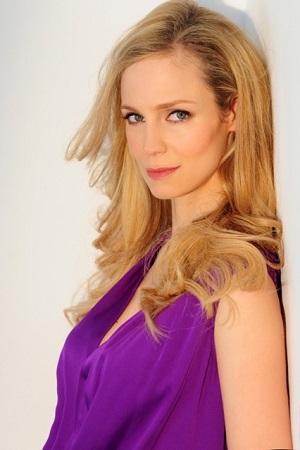Laura Regan, Former ‘Mad Men’ Cast Member, Talks about the Challenges of Adapting Ayn Rand

Actress Laura Regan. Photo Credit: Russell Baer.
When describing what attracted her to the role of Dagny Taggart in Atlas Shrugged: Who Is John Galt, Canadian actress Laura Regan ignores any of the ideological controversies surrounding the project and characterizes the movie as “an opportunity to portray a great literary heroine.” The response provides a constructive context for a film that is being both hailed and dismissed as a political tract; it’s a creative endeavor, not propaganda.
The film is the final installment of a trilogy adapting Ayn Rand’s 1957 novel-cum-manifesto that imagines a dystopian future in which the leaders of industry abandon their responsibilities in response to strangling government regulations. Regan, who is the third actress to play Taggart in as many films, is following Orange Is the New Black star Taylor Schilling and American Psycho actress Samantha Mathis as Rand’s brazen protagonist. Because the film evokes Rand, it inherits all of the controversies that surround the author and her ideas, which poses everyone involved in the film with a unique dilemma.
After more than a decade in the industry, Regan has proved she is up for the challenge. A busy mother of two, she has worked on several prestigious projects, including acting alongside Bruce Willis and Samuel L. Jackson in M. Night Shyamalan’s Unbreakable (2000) and Mad Men, on which she landed a recurring role as Jennifer Crane. The dynamic actress is also familiar with the responsibilities of a starring role. She carried the Wes Craven-produced They (2002), and went through a crash course in military procedures to take on the title role in NBC’s TV-movie Saving Jessica Lynch (2003), another film that got caught in the political crossfire. In-between these projects, she has worked with several charities to help alleviate droughts in the Southwest and engineer sustainable water solutions, while making guest appearances on popular television series, including Law and Order, NCIS and Bones. With the leading role in Atlas Shrugged and one in the upcoming NBC show Constantine, the striking actress is poised to raise a lot of eyebrows in the coming months.
Recently, Regan took the time to talk to GALO about her career so far and the challenges of adapting Ayn Rand.
GALO: Your career has such a long and varied list of credits, it’s hard to encapsulate. Which projects have stood out to you as highlights and which roles are you most proud of?
Laura Regan: There are a few highlights. Unbreakable was my very first role, and it was a big M. Night Shyamalan movie. It was kind of a funny one because I was so new and green that I went to a second audition in Philadelphia, and I remember afterward calling someone and saying, “Oh my God, the casting director has a poster for The Sixth Sense in his office!” I had no idea that I had just met M. Night Shyamalan.
The first movie where I really owned the show was They. That one always stands out in my mind as an incredible learning experience. I also really liked the film, but for me it was where I learned to work. If you’ve done 75 hours that week and they tell you that you have a shoot on Saturday, then that’s what you have to do. Up until then, acting was something quite precious, but on They I learned that you just need to show up and do your job. I was young and I learned that I had to take [acting] very seriously and that it was hard work.
I loved Saving Jessica Lynch, and being on Mad Men was another highlight — it’s become such a cultural touchstone and to be a part of it was incredible. And then [Atlas Shrugged] has been a highlight; I was the heroine of the film and surrounded by great actors, so that was a huge thrill for me.
GALO: You had a recurring role on Mad Men as Harry Crane’s wife, and that show has so many acclaimed pieces, from the actors, to the writers, to the costume designers. Could you describe what it was like stepping onto that set?
LR: I stepped on in the second season, when the first season was already getting incredible acclaim, and I have to admit that I was [a bit] apprehensive [about it] because I wanted to do a really good job. When something is so successful and people want to maintain that level of success (and every choice is looked at very carefully, from the wardrobe to what stocking you’re wearing with the shoes), you get the sense that everyone is being very precise, so I didn’t want to be the one to screw it up [laughs]. So there was a bit of pressure, but right away I realized that the cast and crew were great people to work with, and it became a fun place to go every time I went back.
GALO: This particular trilogy of films is unique in that each one has an entirely different cast and creative team. How much did you and the rest of the cast and crew focus on fitting this installment into the continuity established by the first two films?
LR: It would have been very difficult to do that. Even though the book was broken into three parts, it’s such a long book; we still had trouble squeezing all of it in. In terms of the material and the casting, you really had to look at the movie as its own project. And so far, the fans of the book seem to appreciate that. But especially for the people who want to go see it fresh, who haven’t seen the first two films, it sort of stands on its own because we approached it that way.
